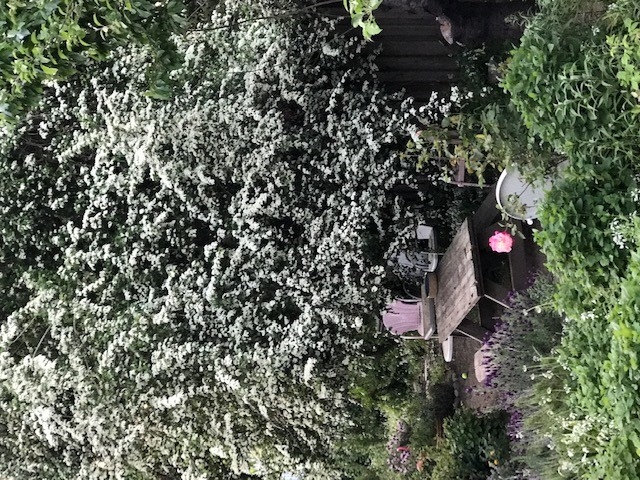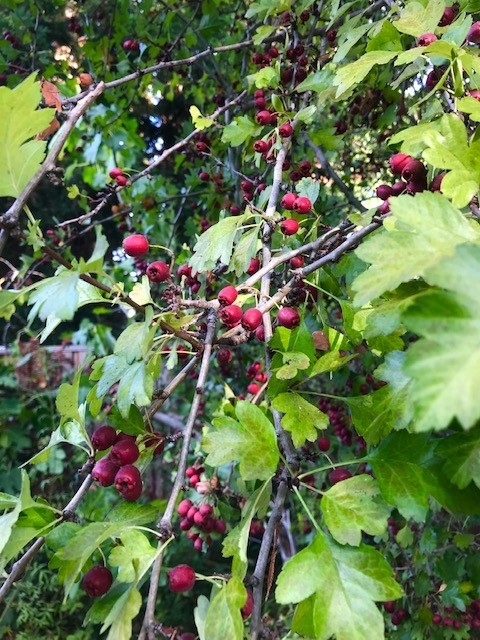Several decades ago, I went hiking on Mount Tamalpais with the mother of a good friend. She handed me a burlap bag—reason unknown—and off we went. I soon found out why she wanted me to carry a bag. She pulled out a terrifying little whip with a knife on the end and, every so often, she would hiss “invasive!” and hand me a hapless sprig she had cut out of the ground.
Mrs. Winston was a stalwart of her local California Native Plant Society chapter, and her mission was to expunge every misbegotten non-native plant from the mountains of Marin. In a short time, the bag was full, and I dragged it down the path, wondering why on earth Mrs. Winston was so upset over a few plants.
I remembered this walk when I decided to write about my English hawthorn tree (Crataegus monogyna), a species in the rose family. The hawthorn towers in my backyard. In the spring it is covered with a veil of white blossoms, and in the winter, it sports red berries that the birds love. It also provides habitat and a hiding place for birds.
I let the leaves of the hawthorn rot on the ground, and they form a layer of decaying vegetation that supports all sorts of insects that birds eat. I have seen birds hide in the leaves when a hawk comes around. While researching my thriving tree, I learned that it, too, is an invasive plant.
According to the University of California, a plant is invasive if it can cause ecological change, spread without human help, grow rapidly, and adapt easily to an environment. Most California invasive plants were introduced by a well-intentioned ornamental horticultural industry or to combat erosion. That's how we got periwinkle (Vinca major), pampas grass (Cordateria selloana), English ivy (Hedera helix), Scotch broom (Cystisus scoparius) and other brooms.
These plants are scourges in Napa County. Broom was planted for erosion control and is now a pest in Westwood Hill Park. Community members have regular broom-eradication days there. Ivy and periwinkle are attractive, but if they curl around trees, they can cause rot. Ivy is also a favored rat habitat.
Pampas grass was popular in the 1950s—a complement to mid-century modern architecture—but it quickly got out of control. I see it often in Napa. No one recommends it for landscaping anymore.
With 5,000 native plants, California has the greatest natural botanical diversity of any state. About 1,500 non-native plants have also become established here and some are invasive.
Our agricultural economy is enormous, and it can be harmed by invasives. They can change the landscape, compete for nutrients and water, or simply attract wildlife that will harm crops.
Invasives can disrupt natural ecosystems, causing a reduction in wildlife. For example, waterways that are choked with reeds attract fewer songbirds because birds won't nest in the reeds.
If you search for a list of invasive plants online, you will likely recognize several that are in your yard. I have wild allium (onion), ivy, calla lilies and Himalayan blackberry.
Some non-native plants “naturalize,” meaning they spread without human intervention. Some daffodils fall into that category. They don't harm the environment because their spread is limited.
“Noxious” is a legal term in California. It is used to describe invasive plants that are “troublesome, aggressive, intrusive, detrimental or destructive to agriculture, silviculture or important native species and difficult to control or eradicate.” Noxious plants include all manner of thistles, purple loosestrife, giant hogweed, tree of heaven and poison hemlock, among others. (I noticed that noxious plants have unusually vivid names.) Occasionally government agencies will step in to eradicate them.
In my online search for home remediation, I found several sites that advocated glyphosate (Roundup). We don't use that anymore around my house. The best eradication method is to remove the plant by the roots.
In the case of my hawthorn, I can't afford to cut it down. I also like the shade and privacy it gives and the birds it attracts. It's not the worst invasive in the world, I rationalized. The City of Napa planted one 30 years ago in the strip across the street from my house. And I live two blocks from Fuller Park, which is famous for its exotic trees.
I am thinking about preparing myself for my hawthorn's inevitable death by planting a native oak somewhere in the yard. I also will hot-compost any seedlings that appear instead of giving them to a friend as I had promised. She lives in a rural part of the county, not far from valuable vineyards, near the Napa River. English hawthorn does particularly well near waterways.
Do your research before you plant. That is always good advice but especially so with regard to invasives. My calla lilies are confined, I cut back the ivy and blackberries every year, and I am resigned to eating as many wild onions as I can every spring. I planted none of those, by the way.
Last year I met a young man at a Master Gardeners' composting workshop. He was a gardener at the facility where we held the workshop. I admired a tree he was manicuring, and he told me it was a Russian olive tree. I asked him if it needed much care. No, he said, and that was the problem.
Russian olive is an invasive plant that needs little help to thrive. Consequently, he makes sure to dispose of any sprouts.
Years before, as a Cub Scout, he had planted hundreds of these trees in Colorado to stabilize soil near waterways. Years later, descendants of these same trees had invaded the riparian environment, and he spent his college summer vacations pulling thousands of them out of the water.
Food Growing Forum:Join UC Master Gardeners of Napa County for a free workshop on “Favoritie Food Plants” on Sunday, November 12, from 3 pm to 4 pm via Zoom. Master Gardeners will share the edible plants that they consider to be must-haves in their gardens. Get cultivation and harvest tips, too. Register Here to get the Zoom link.
Gardening Workshop: Join UC Master Gardeners of Napa County for a free workshop on “Gardening with the Masters” on Saturday, November 18, from 10 am to noon, at Ole Health Garden, 300 Hartle Court, Napa. Children five and older are welcome if accompanied by an adult. Class size is limited. Register to attend.
Help Desk: The Master Gardener Help Desk is available to answer your garden questions on Mondays and Fridays from 10 am until 1 pm at the University of California Cooperative Extension Office, 1710 Soscol Avenue, Suite 4, Napa. Or send your questions to mastergardeners@countyofnapa.org. Include your name, address, phone number and a brief description

